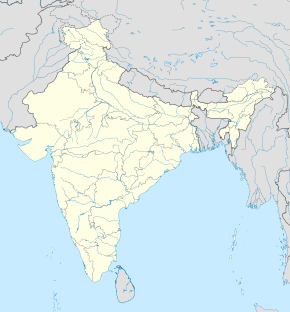This article may require copy editing for grammar, style, cohesion, tone, or spelling. (March 2024) |
The Conquest of Mandaran was an important military conflict that took place between the Bengal Sultanate and the Gajapati Kingdom of Orissa. It occurred during the reign of Rukunuddin Barbak Shah of the Bengal Sultanate and Gajapati Kapilendra Deva of Orissa. The expedition was primarily aimed at the town of Gar Mandaran, which had previously been under the influence of Kapilendra Deva before being captured by the earlier sultan. The expedition was led by Shah Ismail Ghazi, a prominent general of the Bengal Sultanate who had previously led successful campaigns against neighboring kingdoms.
| Conquest of Mandaran | |||||||||
|---|---|---|---|---|---|---|---|---|---|
| |||||||||
| Belligerents | |||||||||
| Bengal Sultanate | Gajapati Kingdom | ||||||||
| Commanders and leaders | |||||||||
| Shah Ismail Ghazi | Kapilendra deva[3][4] | ||||||||
Location within West Bengal | |||||||||
Background edit
Earlier during his reign, Kapilendra Deva led multiple campaigns against neighboring kingdoms. He also launched a campaign against Gar Mandaran, located in present-day West Bengal, capturing it during the reign of Mahmud Shah of Bengal. However, the fort did not remain under Kapilendra Deva's control for long, as it was subsequently seized by Shah Ismail Ghazi.[5][6]
The Siege edit
The siege was launched against the Gar Mandaran Fort in West Bengal, which had come into the possession of the Gajapatis during the earlier reign of Kapilendra Deva. This was one of the significant events that took place during the earlier reign of Rukunuddin Barbak Shah. Shah Ismail Ghazi, an esteemed military general believed to have been born into a Quraysh family in Mecca, made his mark in Bengal after joining the Bengal sultan in his campaigns.[7] Shah Ismail Ghazi was eventually tasked with leading a campaign against the Gajapati kingdom under the rule of Kapilendra Deva.[7] Upon reaching Gar Mandaran fort, which was under the possession of Gajapati Kapilendra Deva, a fierce battle ensued, resulting in Ghazi's victory over the Raja of Orissa and the complete capture of Gar Mandaran fort.[8][9][10] Following this triumph, he pursued the Orissan forces up to Puri, where he successfully sacked the city. Ghazi's return with a considerable amount of booty and the victorious capture of Gar Mandaran fort solidified his reputation as a formidable military leader.[11][12]
Aftermath edit
The capture of the Gar Mandaran fort by the Bengal Sultanate proved to be a significant milestone, ensuring undisrupted rule in the region for the subsequent years of Rukunuddin Barbak Shah's reign.[13]
References edit
- ^ N. Hanif, N. Hanif (2000). Biographical Encyclopaedia of Sufis South Asia. Prabhat Kumar Sharma, for] Sarup & Sons. p. 117-118. ISBN 9788176250870.
- ^ World, Mintage. "Gold Tanka of Bengal sultan Rukn al din Barbak". Mintageworld.com.
- ^ Sengupta, Nitish (2011). Land of Two Rivers A History of Bengal from the Mahabharata to Mujib. Penguin Books Limited. p. Chapter:Later Ilyas Shahi Dynasty. ISBN 9788184755305.
- ^ Mukherjee, Prabhat (1981). The History of the Gajapati Kings of Orissa and Their Successors. Kitab Mahal. p. 28.
- ^ Mukherjee, Prabhat (1981). The History of the Gajapati Kings of Orissa and Their Successors. Kitab Mahal. p. 28.
- ^ Sahu, N. K. (1980). A History of Orissa. Bharatiya Publishing House. p. 385.
- ^ a b Hanif, N. (2000). Biographical Encyclopaedia of Sufis: South Asia. Sarup & Sons. pp. 117–118. ISBN 978-81-7625-087-0.
- ^ Haque, Mohammed Anwarul (1980). Muslim Administration in Orissa, 1568-1751 A.D. Punthi Pustak. p. 32.
- ^ The Orissa Historical Research Journal. Superintendent of Research and Museum. 1993. p. 93.
- ^ Sengupta, Nitish K. (2001). History of the Bengali-speaking People. UBS Publishers' Distributors. p. 64. ISBN 978-81-7476-355-6.
- ^ Md, Abu Musa (2000). History of Dhaka Through Inscription and Architecture: A Portrait of the Sultanate Period. Department of Archaeology, Ministry of Cultural Affairs, Government of the People's Republic of Bangladesh. p. 111. ISBN 978-984-773-006-6.
- ^ Haque, Mohammed Anwarul (1980). Muslim Administration in Orissa, 1568-1751 A.D. Punthi Pustak. p. 32.
- ^ Mondal, Sushila (1970). History of Bengal: The middle age, 1200-1526. Prakash Mandir. p. 188.

